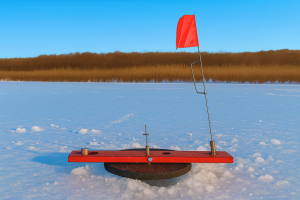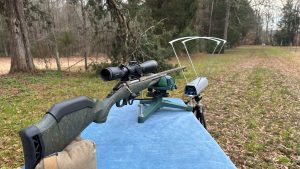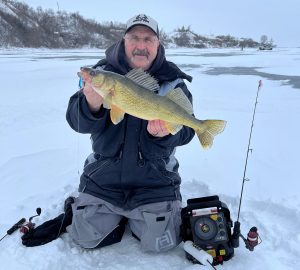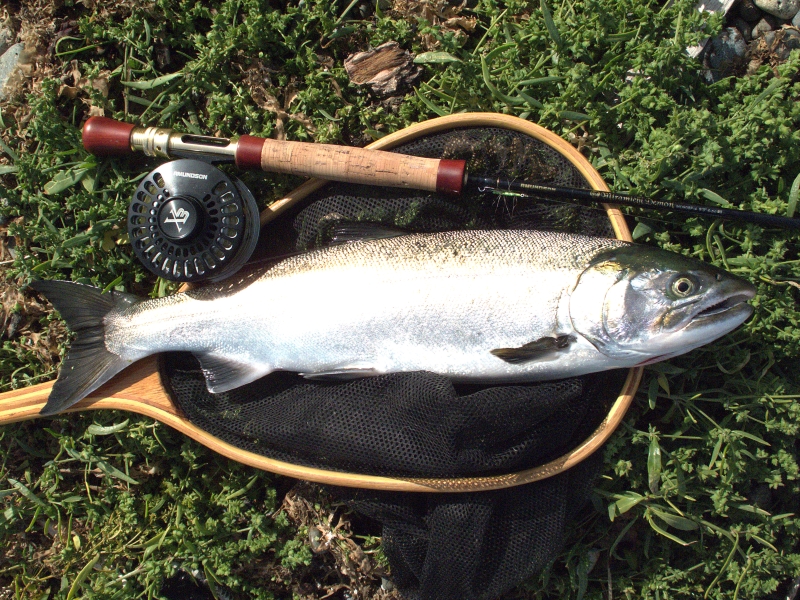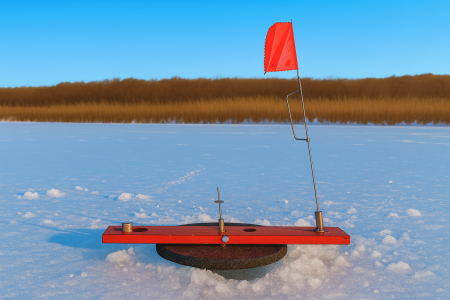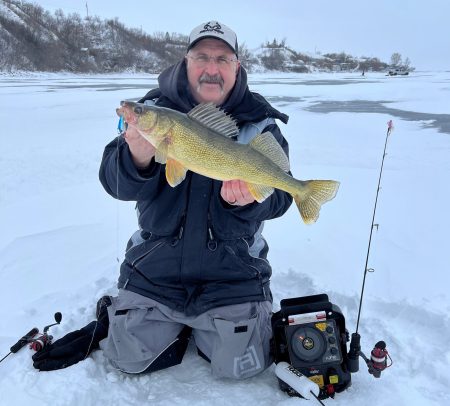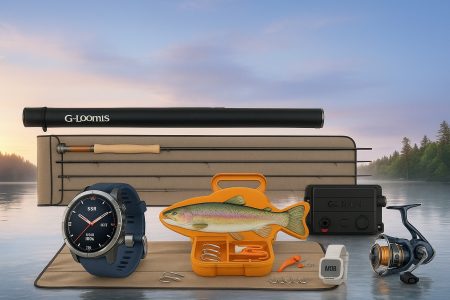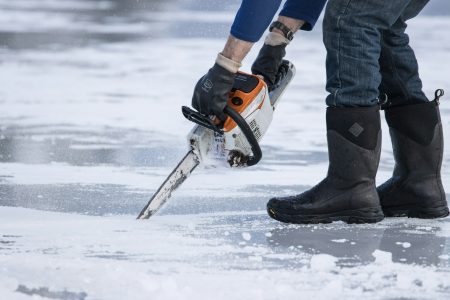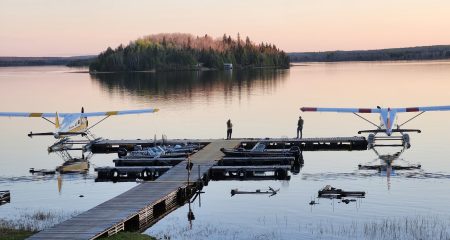“Darn!” I exclaimed. I severely under-powered my cast and awkwardly piled the line up near where the salmon had risen. Frantically stripping in line to take up the slack and impart movement to the streamer before the fish moved off, I barely got the slack retrieved when the line went tight and a violent slosh broke the water where my fly used to be.
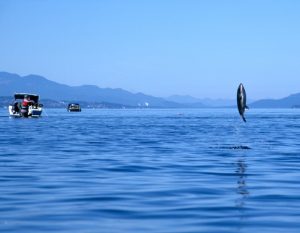
“There he is!” I exclaimed aloud. All eyes turned my way as the coho salmon accelerated to maximum speed and headed for Alaska. My reel was paying out line so quickly I was afraid it would overheat and seize before I got a chance to slow the salmon down. I started sloshing my way in the direction the fish was heading as quickly as I could but the gap between us kept increasing at a frightening rate. Finally, after a run of at least 75 yards, the fish slowed, stopped, and began a series of rolls and tail-slaps. I reeled frantically and managed to gain a few feet of precious line, but the fish seemed to sense what was happening and ran again, still heading away from me.
I continued to push my way through the water, all the while thinking “I’m gonna run out of line.” The fish stopped again, and I glance at my reel to see the metal of the arbor through the remaining backing . . . I had less than 5 yards left. I kept the rod tip up and the pressure on as I reeled in more line. After a minute or so I manage to retrieve 20 more yards of line, but the coho ran again, still heading directly away, and just as it slowed a third time it reached the end of my backing. I felt the line grow taught and as my heart sank the salmon gave one final pull, the tippet snapped and my line went slack. I was devastated. After a minute or two of agony, I tried to console myself by thinking that it was better to have hooked up and lost than to not have hooked up at all, but it didn’t help much.
Scenes similar to this one play out many times every autumn along the shores of the bays and estuaries of British Columbia’s south coast. Fly-fishing for coho is one of my favorite forms of angling and is becoming increasingly popular as anglers look to the sea for an exciting change from the freshwater trout scene.
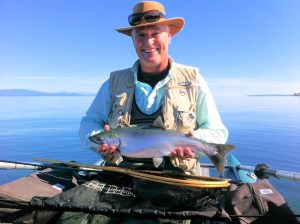
The coho salmon run on the southern coast of British Columbia occurs in late September through October. To make beach fishing for them possible, the water levels in the rivers must be low, so low that the salmon cannot, or will not, enter them in numbers until the waters rise again. When river levels are too low, the fish stack up in the estuaries and bays waiting for the rains. The longer the water levels stay down, the better the fishing gets as more and more salmon keep arriving, hoping to head upstream. If we have a very rainy early autumn though, you can forget the beach fishing; the fish will head straight up the rivers without stopping.
How to Select the Right Gear to Fly Fish for Coho Salmon
Before you grab your gear and run out the door to pursue coho from the beach, there are several important points you must consider: first off, coho salmon are bigger, stronger, and faster than trout. This requires you to use heavier systems than you would with trout because a five-weight system just will not do the trick. A seven or eight weight system is much better suited to handling these water rockets.
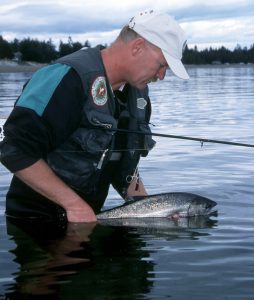
Second, your rod should be at least nine feet in length and you may want to consider going to a 10 foot. You will be wading deep, often well past your waist, and at that depth you don’t have a lot of clearance between the line and the water’s surface; the longer the rod the farther you can cast.
You will definitely need a specialty line. Distance casting is essential for this type of fly-fishing and a weight-forward or shooting head is necessary. I have used many lines for this type of fishing and have found Rio’s “Outbound” with a 30-foot sinking tip to be a great choice. It is an excellent line that provides slow sinking tips with great distance performance.
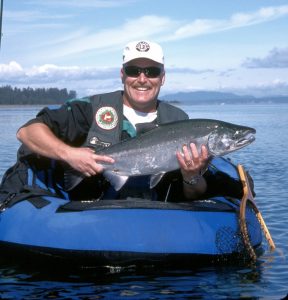
Coho are easily spooked in shallow water and, if you use a sinking line, one that blends into the background is best. All the well-known line manufacturers make intermediate clear sinking lines now and these have proven best at not spooking the fish while not sinking so quickly that you hit bottom during your retrieve.
Of all the pieces of equipment that you pack around when fly-fishing, your reel will be tested the most by these salmon. Corrosive salt water and fish hell-bent on breaking the sound barrier have destroyed more reels than I care to mention. Salt resistant components are essential, especially if you won’t clean your equipment at the end of each day. Reliable disc drags are also necessary; gear or ratchet drags are neither smooth enough nor strong enough to slow a 10-pound coho in flight. The reel should also have a capacity of 150 – 200 yards (and sometimes even that isn’t enough) because coho will strip off a lot of line in their initial runs.
You are faced with a bit of a quandary when deciding which reel to purchase for salmon fishing. Either you buy an expensive reel with a good warrantee that will last you many seasons, and ensure you maintain it, or you buy several inexpensive reels over the same time period and toss them when they breakdown or wear out. I have settled on the middle ground, that way I am always fishing with a fairly new saltwater proof reel and am not worried about beating it up or not cleaning it every night. That’s not to say that the reels I use are cheap, just not exorbitantly expensive. I still ensure they are of good quality, salt water guaranteed, have reliable drags, and enough line capacity before I buy them. I also buy only large arbor reels now, especially for these fish. An added bonus to purchasing moderately priced reels is that extra spools are less costly than those required for the more expensive reels.
Selecting the Best Waders for Coho Salmon fishing
Something else that you must consider is that, unlike rocks and logs in freshwater, rocks and logs in the ocean have barnacles on them. If you kneel down to dislodge a hook or revive a fish, these little razor-toothed crustaceans can make short work of soft-soled wading boots and misplaced knees. Your waders should have reinforced knees, and you should have good quality wading boots. Here again, salt water will eat your wading boot eyelets over the seasons, so be aware of that. The cost of investing in a well-built and protected pair of waders and good boots will save you hundreds in the end.
Choose the right Waders: All About Waders
Pick the Right Vest
You may want to rethink this tactic if you wear a standard-length fishing vest. Deep wading often soaks the lower pockets, especially when waves come in from passing boats, thus getting everything therein drenched in saltwater. Usually, we fly-fishers keep our fly boxes in the lower pockets, and it only takes a few hours to turn your nice clean flies into a pile of rusty feathers and steel. I like wearing my vest though; I pack a ton of stuff with me. My option is to wear a “shorty” vest which is just what it sounds like, a vest half the length of a normal one.
Review the options for vests: Our Picks, the Best Fly Fishing Vests
Techniques for Getting Your Fly Down to the Fish
You fish three to ten feet deep when you angle from the beach for coho. Often the salmon cruise within a foot of bottom. This calls for a technique that will get your fly down to the fish while not hanging up on bottom. There are several methods of doing this and each has its advantages. My preferred method is using an intermediate full sinking or sink-tip line. These lines are neutral density, so they are neither lighter nor heavier than water. This allows the line to sink very slowly, and once a retrieve is started, it doesn’t sink too deep. This capability allows you to get the line down below the surface wave action so that the waves don’t interfere with your presentation and retrieve, but still sinks slowly enough to let you to retrieve it without snagging bottom. It does take some time to sink though, and this may try your patience. Tidal currents also affect the intermediate sinking lines more than other sinking lines since they are slower to sink to the depth you want to fish them at, and I have been frustrated with them in a heavy tide.
Selecting Fly line: Guide to Picking the Correct Fly Line
Another method employs a full floating line. Using a dry line allows much more line control and is nicer to cast than a sinking line, but you often won’t get your fly deep enough unless you use a weighted fly (and we all know what a joy it is to cast a weighted #6 fly). In addition, the dry line sits on the surface and rises, falls and meanders with the surface wave action and tidal current. This affects your retrieve, and ultimately how your fly appears to the fish.
Regardless of your method, the flies and retrieves are the same. As I mentioned earlier, Coho salmon in skinny water are easily spooked. This requires using long leaders; 15 or more feet is very common. I used to work hard at finding heavy tapered leaders but I now simply use 12 or 14-pound test monofilament looped straight off my connector. It is cheap and it works. The heavy tippet is necessary because anything lighter tends to break easily on these fish and you want to be able to employ your reel drag to tire the fish or you will never get it in. One problem with level monofilament is that it is difficult to roll your casts over, especially casting big flies. However, if you use the clear fly lines that I mentioned earlier, you can use a much shorter leader and this combination makes it much easier to roll the cast over.
Selecting the Proper Fly to Catch Coho Salmon
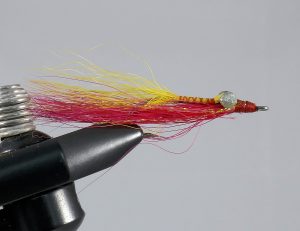
Flies are simple ties of # 8 – #2 stainless steel or nickel-plated hooks with overwings of blue, pink, green, yellow or white bucktail. Tie a few of each and try mixing some yellow under with green over, etc. Throw in half a dozen lengths of crystal hair for more flash and there you have it, a good assortment of coho flies. Since the coho feed on an assortment of goodies, from herring and needlefish to krill, an assortment of different colored flies is needed.
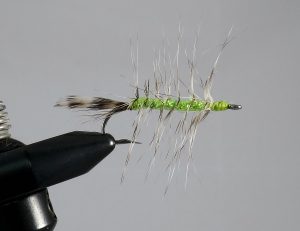
There is nothing special to learn about actually fishing for these salmon. If you see rolling coho, cast just ahead and past the school. If you don’t actually see fish, then prospect by making casts as far as you can, getting the fly down to within a few feet of the bottom, and retrieving it with quick strip retrieves. Often when you are stripping in the fly you will see a wake move in from behind the fly and follow it. As much as you would like to, don’t change the retrieve. If you suddenly change the fly’s speed or motion the fish will refuse it and turn away. Maintain the retrieve and ready yourself for the strike. If the coho strikes set the hook, raise the rod tip, and hang on ’cause you’re in for one heck of a ride!
Options for Carrying your Flies: Pick the Right Fly Box
Read more of Bill Luscomb’s Fly Fishing Tips.
Per our affiliate disclosure, we may earn revenue from the products available on this page. To learn more about how we test gear, click here.

